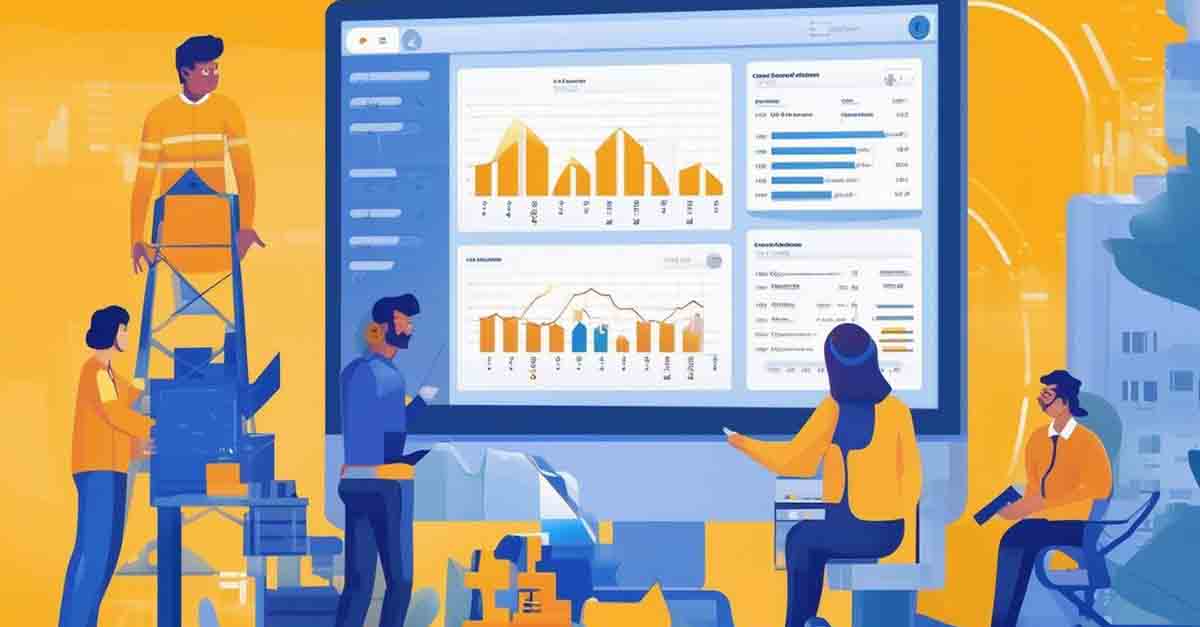
Integrated Workplace Management Systems (IWMS): A Complete Guide
Explore how IWMS transforms operations by centralizing facilities, assets, and space management to drive efficiency, cost savings, and smarter ...
Solutions
Workplace Management Solutions
Real Estate Management Solutions
Maintenance Management Solutions
Energy Management Solutions
Engineering Document Management Solutions
Asset Management Solutions
Automate campus scheduling for classes, meetings, and exams with our EMS software.
Plan and manage conferences effortlessly with EMS software to impress guests and streamline operations.
Boost workplace flexibility and maximize space use with seamless desk and room booking.
Organize workplace or campus events smoothly, creating memorable experiences.
Optimize workspace, manage allocations efficiently, and reduce costs with our space management solutions.
Deliver projects on time and within budget by improving communication, collaboration, and efficiency with our software.
Streamline lease accounting for ASC 842, IFRS, and GASB compliance.
Manage leases efficiently by tracking key dates, analyzing costs, and ensuring compliance.
Centralize data and analytics for better insights, faster negotiations, and revenue growth.
Centralize facility and asset maintenance, automate work orders, and ensure compliance with our CMMS software.
Extend asset life, reduce downtime, and prevent costly repairs with data-driven monitoring.
Prevent equipment failures and extend asset life by detecting and addressing issues early.
Make sustainable, cost-efficient energy decisions by monitoring and optimizing power consumption.
Remotely monitor and control equipment with real-time data to predict issues, boost efficiency, and reduce downtime.
Easily share and collaborate on documents, creating a single source of truth for engineers and contractors.
Manage and analyze assets across their lifecycle to schedule maintenance, reduce downtime, and extend lifespan.
Improve visibility, automate work orders, and ensure compliance for efficient facility and asset management.
Resources
Browse our full library of resources all in one place, including webinars, whitepapers, podcast episodes, and more.
Support
Looking for access to technical support, best practices, helpful videos, or training tools? You’ve come to the right place.
About Accruent
Get the latest information on Accruent, our solutions, events, and the company at large.

CAFM software enhances facility management by streamlining operations, reducing costs, and improving decision-making. It integrates space planning, maintenance, and compliance to optimize efficiency.
In an era where efficiency, sustainability, and strategic planning are at the forefront of organizational goals, facility management has transcended its traditional boundaries. No longer seen as a mere support function, it is now recognized as a critical driver for operational and strategic success. This transformation has been significantly propelled by the advent and integration of Computer-Aided Facility Management (CAFM) systems.
These sophisticated software solutions serve as the linchpin in modern facility management, offering a blend of technology and functionality designed to optimize the use and management of facilities. This blog delves deeper into the functionalities, benefits, and future prospects of CAFM, highlighting its pivotal role in reshaping facility management.
CAFM is not merely a set of software applications; it is a strategic enabler that bridges the gap between operational demands and organizational goals. It encompasses a broad spectrum of functions:
Deep Dive into CAFM Features

The implementation of CAFM systems brings transformative benefits:

CAFM's versatility makes it indispensable across various sectors:
“For me, all of the asset module information, the level of detail that I can extract on asset data makes my life so much easier. I can report back on warranty information and life expectancy, things that were written down in binders.”
- Alan Siero, Assistant Director, System Administration and Client Services, University of California - Riverside
“We’ve not only been able to achieve our goals, but set new standards. Our goals before FAMIS were simply to repair or replace. Now, we’ve been able to achieve our target of reducing unanticipated requests by 80%.”
- Sarah McGing, Facilities and Operations Manager, Columbia College Chicago
“Every single asset that we own that has any value at all is in FAMIS, and we have prescribed PM schedules in there.”
- Andrew Leete, Systems Manager, UConn Health
|
Aspect |
CAFM (Computer-Aided Facility Management) |
CMMS (Computerized Maintenance Management System) |
|---|---|---|
|
Primary Focus |
Comprehensive facility management, including space planning, asset tracking, and occupancy management. |
Maintenance operations, focusing on scheduling, tracking, and managing maintenance tasks and assets. |
|
Core Functions |
|
|
|
Typical Users |
Facility managers, space planners, real estate professionals. |
Maintenance managers, technicians, operations personnel. |
|
Data Integration |
Often integrates with CAD and BIM systems for detailed spatial analysis and planning. |
Primarily integrates with maintenance tools and systems; some advanced CMMS solutions may offer broader integrations. |
|
Decision Support |
Provides data for strategic planning related to space utilization, asset management, and facility operations. |
Offers insights for maintenance optimization, asset reliability, and operational efficiency. |
|
Implementation Scope |
Broader scope encompassing various aspects of facility management. |
Focused scope centered on maintenance activities and asset upkeep. |
|
Cost Consideration |
Generally higher due to broader functionality and integration capabilities. |
Typically lower, with costs varying based on features and scale. |
|
Ideal Use Cases |
Organizations seeking to optimize space utilization, manage facilities comprehensively, and plan strategically. |
Organizations aiming to streamline maintenance processes, reduce downtime, and manage assets effectively. |
The future of CAFM is marked by several exciting trends:
The journey towards implementing CAFM is not without its challenges, but by laying down a strategic foundation, organizations can harness its full potential. Success lies in setting clear objectives, engaging stakeholders, providing thorough training, and choosing adaptable, user-friendly software.
Accruent solution unifies all aspects of facility operations into one platform. By automating routine tasks and centralizing data, it streamlines facility workflows and boosts efficiency. The integrated system provides a single source of truth for facilities teams, helping them reduce costs, improve maintenance outcomes, and make informed decisions backed by real-time insights.
For Facility Managers: Centralizes maintenance requests, space planning, and asset tracking, reducing inefficiencies. Automated workflows ensure preventive maintenance is completed on time, extending equipment lifespan and reducing downtime.
For Real Estate Teams: Lease tracking and portfolio management tools help real estate teams stay on top of deadlines and cost analysis. Automated alerts prevent missed lease renewals, and reporting tools provide insights to optimize space usage and expenses.
For Energy & Sustainability Managers: Tracks energy consumption across facilities and helps identify inefficiencies. Managers can implement sustainability initiatives, reduce utility costs, and ensure compliance with environmental regulations.
For Executives (ROI & Cost Savings Focus): Leadership teams gain visibility into facility performance, costs, and operational efficiency. The software helps reduce real estate expenses, improve workforce productivity, and support long-term strategic planning.
Discover how leading organizations leverage Accruent solutions to optimize facility management, improve asset maintenance, and streamline operations. These real customer stories highlight the transformative impact of our solutions across industries.
UC Riverside improved asset reporting and maintenance efficiency, ensuring compliance and minimizing equipment downtime. See how UC Riverside achieved real-time asset tracking and streamlined operations.
Anoka County implemented FAMIS Maintenance Management to oversee assets and expand services without increasing costs. Learn how Anoka County improved resource allocation and service delivery.
Columbia College Chicago centralized work order tracking, enhancing response times and workflow visibility. Discover how Columbia College optimized its facility maintenance processes.
Montana State University successfully migrated historical data to a cloud-based CAFM system, ensuring data integrity and fixing long-standing errors. Read how Montana State University safeguarded critical facility data.
CAFM is software that streamlines facility operations, including space planning, asset tracking, maintenance, and compliance. It centralizes data to improve efficiency, reduce costs, and enhance decision-making across industries like corporate offices, healthcare, and education.
A CAFM system integrates facility management functions into one platform, automating tasks like space tracking, asset monitoring, and maintenance scheduling. It provides real-time insights, automates workflows, and integrates with other systems like ERP and IoT for seamless operations.
By automating workflows, improving space utilization, and optimizing asset maintenance, CAFM minimizes downtime, prevents unnecessary expenses, and maximizes facility efficiency.
Explore how IWMS transforms operations by centralizing facilities, assets, and space management to drive efficiency, cost savings, and smarter ...
Learn how IWMS, or integrated workplace management systems, drive operational improvements through the centralization of real estate and facilities ...
A complete guide to IWMS: Learn how Integrated Workplace Management Software streamlines real estate and facilities management for enhanced ...
Subscribe to stay up to date with our latest news, resources and best practices.
* To unsubscribe at any time, please use the “Unsubscribe” link included in the footer of our emails.